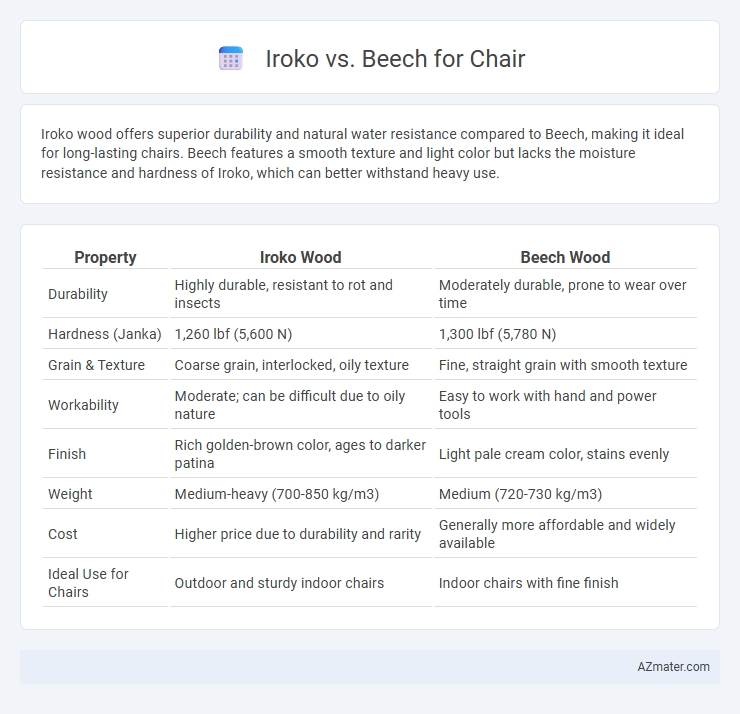Iroko wood offers superior durability and natural water resistance compared to Beech, making it ideal for long-lasting chairs. Beech features a smooth texture and light color but lacks the moisture resistance and hardness of Iroko, which can better withstand heavy use.
Table of Comparison
| Property | Iroko Wood | Beech Wood |
|---|---|---|
| Durability | Highly durable, resistant to rot and insects | Moderately durable, prone to wear over time |
| Hardness (Janka) | 1,260 lbf (5,600 N) | 1,300 lbf (5,780 N) |
| Grain & Texture | Coarse grain, interlocked, oily texture | Fine, straight grain with smooth texture |
| Workability | Moderate; can be difficult due to oily nature | Easy to work with hand and power tools |
| Finish | Rich golden-brown color, ages to darker patina | Light pale cream color, stains evenly |
| Weight | Medium-heavy (700-850 kg/m3) | Medium (720-730 kg/m3) |
| Cost | Higher price due to durability and rarity | Generally more affordable and widely available |
| Ideal Use for Chairs | Outdoor and sturdy indoor chairs | Indoor chairs with fine finish |
Introduction: Iroko vs Beech for Chair Making
Iroko and Beech are popular hardwood choices for chair making due to their durability and workability. Iroko, often called African teak, is prized for its high resistance to moisture, making it ideal for both indoor and outdoor furniture. Beech offers a fine, even texture and excellent strength, providing stability and a smooth finish for indoor chairs.
Botanical Origins and Characteristics
Iroko wood, derived from the Milicia excelsa tree native to West Africa, features a coarse texture with a golden to medium brown hue that darkens over time, making it naturally resistant to decay and insect attacks. Beech, from the Fagus genus common in Europe, exhibits a fine, uniform grain with a pale cream color that may develop a pinkish tinge, prized for its strength and shock resistance. Both woods offer durability for chair construction, but Iroko's higher density and oily resin content grant superior weather resistance compared to the more moisture-sensitive Beech.
Appearance and Color Comparison
Iroko wood features a rich, golden to medium brown color with occasional darker streaks, offering a warm and natural aesthetic ideal for chairs that require a vibrant yet subtle look. Beech wood presents a lighter, creamy pale color with a fine, even grain, providing a smooth and uniform appearance well-suited for modern or minimalistic chair designs. The contrast between Iroko's warm hues and Beech's light tones allows for diverse stylistic choices in furniture, balancing traditional richness with contemporary brightness.
Durability and Longevity
Iroko wood offers superior durability for chair construction due to its high resistance to rot, insects, and moisture, making it ideal for both indoor and outdoor use. Beech wood, while harder and dense, is more susceptible to humidity changes and may warp or crack over time, reducing its longevity compared to Iroko. Chairs made from Iroko typically provide longer-lasting performance and maintain structural integrity better under varying environmental conditions.
Workability and Ease of Crafting
Iroko wood offers excellent workability with its medium density and interlocking grain, making it easier to plane and shape compared to Beech. Beech wood is highly favored for chair crafting due to its uniform grain and fine texture, allowing seamless sanding and smooth finishes. Both woods respond well to common woodworking tools, but Beech is generally preferred for intricate detailing and precision joinery in chair making.
Comfort and Ergonomics in Chair Design
Iroko wood offers superior durability and a naturally oily texture that enhances chair comfort by resisting moisture and maintaining a smooth finish. Beech wood, known for its fine grain and flexibility, provides excellent ergonomic support through its ability to be steam-bent into curved shapes that align with the body's contours. Chairs crafted from beech often excel in adaptive comfort, while iroko ensures long-lasting structural integrity for ergonomic seating.
Cost and Availability
Iroko wood is generally more expensive than beech due to its durability and scarcity, making it a premium choice for high-end chairs. Beech wood offers a more affordable option with wide availability in furniture markets, especially in Europe and North America. Availability of iroko can be limited and region-specific, often imported from West Africa, while beech is more readily sourced from sustainable plantations and local suppliers.
Environmental Impact and Sustainability
Iroko wood, harvested from fast-growing African trees, offers a more sustainable option due to its renewable sourcing and resistance to pests, reducing the need for chemical treatments. Beech, commonly found in European forests, is often sustainably managed through controlled forestry practices but may require more intensive processing because of its density and susceptibility to moisture. Choosing Iroko reduces environmental impact through its durability and lower maintenance, while beech's widespread availability supports sustainable forestry economies when sourced responsibly.
Maintenance and Care Requirements
Iroko wood offers superior resistance to moisture, pests, and decay, making it easier to maintain with just occasional cleaning and oiling to preserve its natural oils and color. Beech wood, while strong and durable, requires more frequent sealing or varnishing to protect against moisture damage and potential warping, especially in humid environments. Regular dusting and avoiding prolonged exposure to water are essential for both woods to extend the lifespan of chairs crafted from these materials.
Final Verdict: Which Wood is Best for Chairs?
Iroko wood offers exceptional durability, natural resistance to moisture, and a rich golden-brown hue, making it ideal for outdoor and heavy-use chairs, while beech provides a lighter, smoother texture with superior shock resistance, perfect for indoor furniture requiring a refined finish. Beech's ability to bend without cracking enhances its versatility for ergonomic chair designs. For long-lasting, sturdy outdoor chairs, Iroko is the best choice, whereas beech is preferred for elegant, comfortable indoor seating.

Infographic: Iroko vs Beech for Chair
 azmater.com
azmater.com